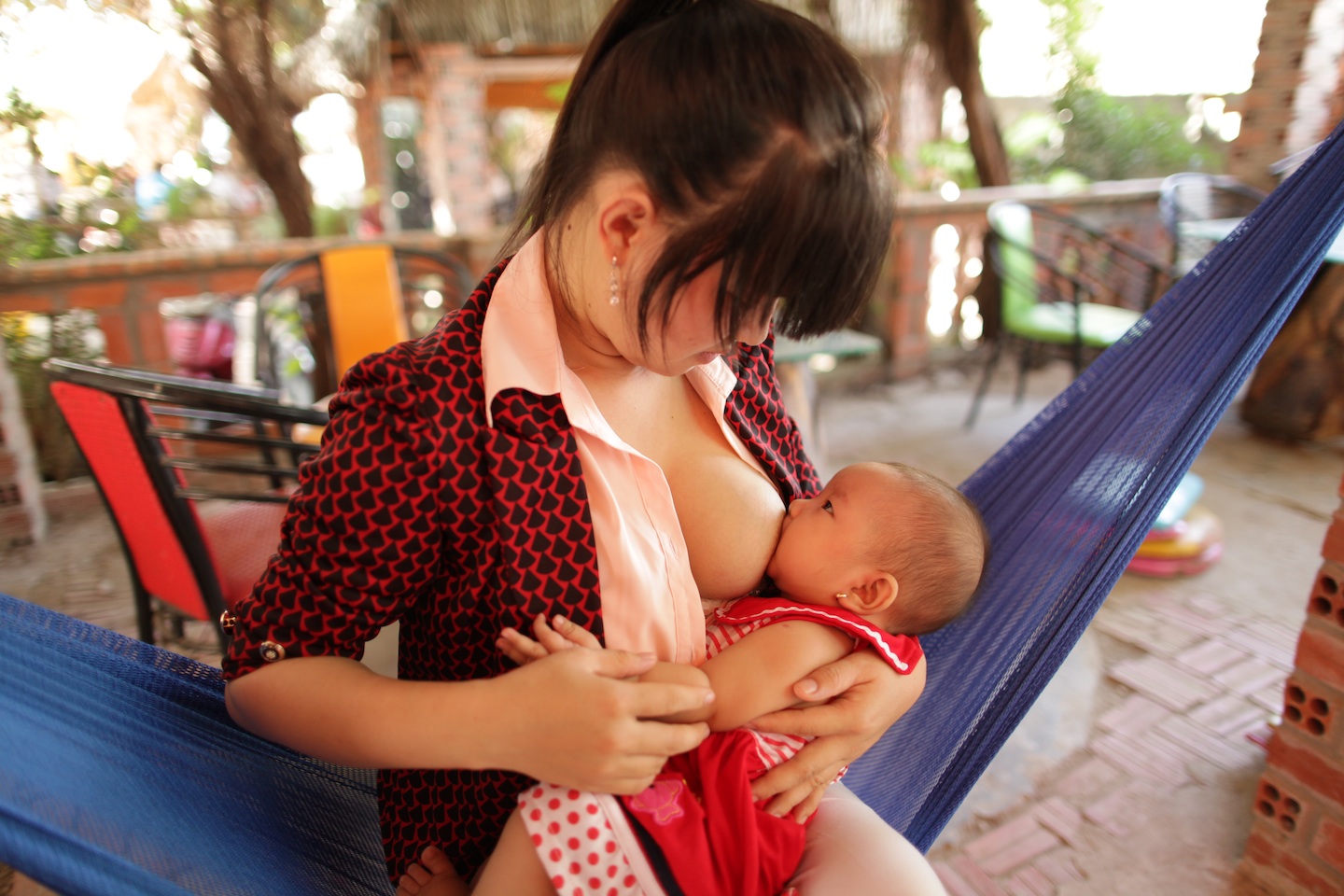

MDG-F sharply boosts breastfeeding in Vietnamese villages

By Andy Brown
Nguyen Anh Dao, 24, breastfeeds her four-month-old daughter at her home in An Giang province in southwestern Viet Nam. The baby is healthy and strong, and can already stand up in her mother’s lap. “I started breastfeeding in the health centre where I gave birth,” Dao says. “Afterwards, the village health worker talked to me about breast milk. She told me that it contains good nutrients and is best for my baby’s health.”
Dao is one of many mothers who are being encouraged to breastfeed through an MDG-F programme to improve nutrition in Viet Nam. While Viet Nam has significantly reduced under-five malnutrition rates over the last three decades, and is cited as a high achiever in the UNDP’s 2013 Human Development Report, malnutrition remains a public health priority. One third of Vietnamese children less than five years old are stunted – or too short for their age - and one third are anaemic.
There is strong scientific evidence that early and exclusive breastfeeding can help reduce neonatal mortality and stunting. But some new mothers in Viet Nam face resistance to breastfeeding from grandparents, who prefer traditional methods such as mixing water with sugar and rice powder. Other mothers have to return to work in the fields and stop breastfeeding exclusively before the recommended six months.
Mekong Delta
Dao’s commune of Binh Thanh Dong is in the Mekong Delta region of southern Viet Nam, a rural area of wide green paddy fields where most people are rice farmers. Here, and in five other provinces, the MDG-F is trying to lower malnutrition rates among the most vulnerable, with a focus on reducing stunting and preventing future malnutrition in children.
At a community centre near Dao’s house, a group of mothers meet for a breastfeeding support group session, where Nguyen Thi Tuyet Phung, a local collaborator, starts by reviewing the learning from the last meeting. Then the mothers talk about their difficulties. One has painful nipples after breastfeeding. Another is concerned that her friend’s baby, who is fed infant formula, is bigger than her own. Their questions are answered by a nurse from the nearby health centre. “Don’t worry if your baby is not as big as your friend’s,” she says. “The important thing is that he is healthy.”
Changing breastfeeding practices
The community support group and local health centre are supported by UNICEF, which is implementing the joint programme in partnership with FAO, WHO and the Vietnamese government. Since the programme began in 2010, the rate of exclusive breastfeeding in Binh Thanh Dong commune has rocketed from 0.5 per cent to 27.9 per cent.
One aim of the programme is to change the behaviour of mothers in small villages. “It’s very challenging,” says UNICEF breastfeeding expert Nguyen Dinh Quang. “Many things influence behaviour and we can’t go to every village. That’s why we work with the health centre to create the community support groups. The collaborators learn the best practice and share it with other mothers.”
The Joint Programme’s policy advocacy also helped pass laws in the National Assembly last year to ban the advertising of infant formula for children under two years of age, and to give new mothers the right to six months’ maternity leave so that they can exclusively breastfeed for the recommended time. “This is a big step forward in Viet Nam,” Quang says.
Teaching by example
Nearby, at Phu Tan District Hospital, 25-year-old rice farmer Dang Thi Thao breastfeeds her second child under the supervision of the chief obstetrician, who provides counselling on how to hold the baby and how to tell when she is full. “I’ve breastfed both my children,” saus Thao. “I feel happy and satisfied when I do it.”
Around 90 per cent of women in the district give birth at the hospital, so it’s an important place to start. The hospital has developed a regulation with ten steps for successful breastfeeding. For example, health workers are required to help every mother to breastfeed within one hour of giving birth.
In the target communities, lactating mothers are being taught by example. Nguyen Thi Tuyet Phung, the 29-year-old village collaborator, was invited to join the programme as a volunteer by staff at the health centre. “I attended training sessions on breastfeeding,” she says. “I liked it very much. I gained knowledge for myself and my family. Now, I can share my knowledge with other villagers and they believe me because they know I work with the health centre. My son is very healthy and I show him as an example. ”
Improving nutrition to achieve the MDGs
The Joint Programme on Integrated Nutrition and Food Security Strategies for Children and Vulnerable Groups in Viet Nam is part of the MDG-Fund’s efforts to help governments around the world achieve the Millennium Development Goals, with a particular focus on reaching the most marginalized populations. The programme in Viet Nam specifically targets MDG 1 on ending poverty and hunger, MDG 4 on reducing newborn and under-five mortality, and MDG 5 on reducing maternal morbidity and mortality.
Through the Joint Programme, the United Nations is focusing its work at both the national and provincial level, targeting several provinces, including Cao Bằng, Điện Biên, Đắk Lắk, Kon Tum, NinhThuận and An Giang. These provinces were selected based on their high levels of stunting as well as the presence of related activities and the capacity of agencies at the field level to implement programme activities.
Photo: © UNICEF Viet Nam/2013/Truong Viet Hung